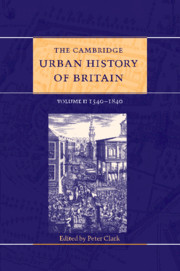Book contents
- Frontmatter
- 1 Introduction
- Part I Area surveys 1540–1840
- Introduction
- 2(a) England: East Anglia
- 2(b) England: South-East
- 2(c) England: South-West
- 2(d) England: Midlands
- 2(e) England: North
- 3 Wales
- 4 Scotland
- Part II Urban themes and types 1540–1700
- Part III Urban themes and types 1700–1840
- Select Bibliography
- Index
- References
2(c) - England: South-West
from Part I - Area surveys 1540–1840
Published online by Cambridge University Press: 28 March 2008
- Frontmatter
- 1 Introduction
- Part I Area surveys 1540–1840
- Introduction
- 2(a) England: East Anglia
- 2(b) England: South-East
- 2(c) England: South-West
- 2(d) England: Midlands
- 2(e) England: North
- 3 Wales
- 4 Scotland
- Part II Urban themes and types 1540–1700
- Part III Urban themes and types 1700–1840
- Select Bibliography
- Index
- References
Summary
the six counties in the South-West of England (Gloucestershire, Wiltshire, Dorset, Somerset, Devon and Cornwall) are not now associated strongly with urbanisation. Apart from Bristol and Plymouth, the region is predominantly one of small and medium-sized towns. The origins of this modern pattern, in contrast with the more heavily urbanised Midlands and (parts of) the North, lie in the period covered here. Yet it would be misleading to portray this period as one of urban decline in the South-West. Not only was there a more than threefold increase in the urban population of the region between 1660 (c. 225,000) and 1841 (just under 880,000), but even in 1841 the South-West, with 40 per cent of its population in towns, was as urbanised as England generally, leaving London aside (see Table 2.6).1 If urban growth in the previous centuries was less spectacular than elsewhere, this was in part because of the strong urban infrastructure already in place, with over a quarter of the region’s people living in towns by 1660, rising to almost 37 per cent by 1801. Furthermore, if the region lacked an outstanding major new town based on manufacturing and commercial success, it had many smaller ones, notably in Cornwall and in the clothing districts around Bristol, and it had the two greatest inland spas – Bath (see Plates 3 and 28) and Cheltenham, the latter the fastest growing large English town between 1801 and 1841. The leisure and tourism industry they personified was already transforming the coastal towns from Weymouth along the south Devon coast and round to Weston-super-Mare and Clevedon on the Bristol Channel.
- Type
- Chapter
- Information
- The Cambridge Urban History of Britain , pp. 67 - 92Publisher: Cambridge University PressPrint publication year: 2000



